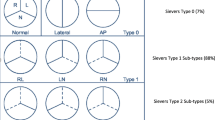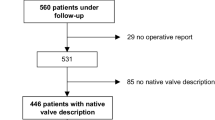Abstract
Although bicuspid aortic valve (BAV) is one of the most common congenital heart diseases, clinical data associated with valve dysfunction are still limited. We evaluated clinical characteristics and echocardiography of French patients with BAV associated with leaking and stenosis degeneration. We initiated a prospective registry from 2014 to 2018 at a tertiary center. A total of 223 patients (168 males [75%], age 53 ± 17 years) were enrolled. Among these patients 83% had left–right coronary cusps fusion, 80% Sievers type 1 BAV and 49% showed aortic dilatation. Twenty-four patients (11%) had normal valve function, 66 patients (31%) had aortic stenosis (AS), 91 patients (41%) had aortic regurgitation (AR) and 40 patients (17%) had AR and AS. BAV phenotype did not predict neither AS nor AR (all p > 0.1). By multivariable analysis, age > 50 (41.6[10.3–248.2], p < 0.001) and presence of raphe/fusion (12.8[2.4–87.4], p < 0.001) were significantly associated with AS, whereas male gender was associated with AR (5[1.6–16.4], p = 0.005). In addition, leaking degeneration was observed at a much younger age than stenosis (44 ± 14 years vs. 66 ± 10 years, p < 0.01) and among patients with valve dysfunction younger age was independently associated with AR (1.9[1.85–1.94], p < 0.001). In this study we confirmed high prevalence of valve dysfunction at first diagnosis of BAV in a referred population. The degenerative process differs according to type of dysfunction and is mainly dependent on age and gender.


Similar content being viewed by others
References
Sievers H-H, Schmidtke C (2007) A classification system for the bicuspid aortic valve from 304 surgical specimens. J Thorac Cardiovasc Surg 133:1226–1233
Garg V, Muth AN, Ransom JF, Schluterman MK, Barnes R, King IN, Grossfeld PD, Srivastava D (2005) Mutations in NOTCH1 cause aortic valve disease. Nature 437:270–274
Michelena HI, Suri RM, Katan O, Eleid MF, Clavel M, Maurer MJ, Pellikka PA, Mahoney D, Enriquez-Sarano M (2016) Sex differences and survival in adults with bicuspid aortic valves: verification in 3 contemporary echocardiographic cohorts. J Am Heart Assoc 5:e004211
Hoffman JIE, Kaplan S (2002) The incidence of congenital heart disease. J Am Coll Cardiol 39:1890–1900
Larson EW, Edwards WD (1984) Risk factors for aortic dissection: a necropsy study of 161 cases. Am J Cardiol 53:849–855
Michelena HI, Prakash SK, Della Corte A, Bissell MM, Anavekar N, Mathieu P, Bossé Y, Limongelli G, Bossone E, Benson DW, Lancellotti P, Isselbacher EM, Enriquez-Sarano M, Sundt TM, Pibarot P, Evangelista A, Milewicz DM, Body SC, BAVCon Investigators (2014) Bicuspid aortic valve: identifying knowledge gaps and rising to the challenge from the International Bicuspid Aortic Valve Consortium (BAVCon). Circulation 129:2691–2704
Michelena HI, Desjardins VA, Avierinos J-F, Russo A, Nkomo VT, Sundt TM, Pellikka PA, Tajik AJ, Enriquez-Sarano M (2008) Natural history of asymptomatic patients with normally functioning or minimally dysfunctional bicuspid aortic valve in the community. Circulation 117:2776–2784
Michelena HI, Khanna AD, Mahoney D, Margaryan E, Topilsky Y, Suri RM, Eidem B, Edwards WD, Sundt TM, Enriquez-Sarano M (2011) Incidence of aortic complications in patients with bicuspid aortic valves. JAMA 306:1104–1112
Baumgartner H, Falk V, Bax JJ, De Bonis M, Hamm C, Holm PJ, Iung B, Lancellotti P, Lansac E, Muñoz DR, Rosenhek R, Sjögren J, Tornos Mas P, Vahanian A, Walther T, Wendler O, Windecker S, Zamorano JL, ESC Scientific Document Group (2017) 2017 ESC/EACTS guidelines for the management of valvular heart disease. Eur Heart J 38:2739–2791
Nishimura RA, Otto CM, Bonow RO, Carabello BA, Erwin JP, Fleisher LA, Jneid H, Mack MJ, McLeod CJ, O’Gara PT, Rigolin VH, Sundt TM, Thompson A (2017) 2017 AHA/ACC focused update of the 2014 AHA/ACC guideline for the management of patients with valvular heart disease. J Am Coll Cardiol 70:252–289
Atkins SK, Sucosky P (2014) Etiology of bicuspid aortic valve disease: focus on hemodynamics. World J Cardiol 6:1227–1233
Sun L, Chandra S, Sucosky P (2012) Ex vivo evidence for the contribution of hemodynamic shear stress abnormalities to the early pathogenesis of calcific bicuspid aortic valve disease. PLoS ONE 7:e48843
Firth D (1993) Bias reduction of maximum likelihood. Biometrika 80:27–38
Michelena HI, Mankad SV (2017) Sex differences in bicuspid aortic valve adults: who deserves our attention, men or women? Circ Cardiovasc Imaging 10:e006123
Roberts WC, Ko JM (2005) Frequency by decades of unicuspid, bicuspid, and tricuspid aortic valves in adults having isolated aortic valve replacement for aortic stenosis, with or without associated aortic regurgitation. Circulation 111:920–925
Kang J-W, Song HG, Yang DH, Baek S, Kim D-H, Song J-M, Kang D-H, Lim T-H, Song J-K (2013) Association between bicuspid aortic valve phenotype and patterns of valvular dysfunction and bicuspid aortopathy. JACC Cardiovasc Imaging 6:150–161
Kong WKF, Delgado V, Poh KK, Regeer MV, Ng ACT, McCormack L, Yeo TC, Shanks M, Parent S, Enache R, Popescu BA, Liang M, Yip JW, Ma LCW, Kamperidis V, Van Rosendael PJ, Van Der Velde ET, Ajmone Marsan N, Bax JJ (2017) Prognostic implications of raphe in bicuspid aortic valve anatomy. JAMA Cardiol 2:285–292
Bäck M, Gasser TC, Michel J-B, Caligiuri G (2013) Biomechanical factors in the biology of aortic wall and aortic valve diseases. Cardiovasc Res 99:232–241
Robicsek F, Thubrikar MJ, Cook JW, Fowler B (2004) The congenitally bicuspid aortic valve: how does it function? Why does it fail? Ann Thorac Surg 77:177–185
Marom G, Kim H-S, Rosenfeld M, Raanani E, Haj-Ali R (2013) Fully coupled fluid-structure interaction model of congenital bicuspid aortic valves: effect of asymmetry on hemodynamics. Med Biol Eng Comput 51:839–848
Yang L-T, Enriquez-Sarano M, Michelena HI (2020) The bicuspid aortic valve raphe: an evolving structure. Eur Hear J Cardiovasc Imaging 21:590–590
Steitz SA, Speer MY, Curinga G, Yang HY, Haynes P, Aebersold R, Schinke T, Karsenty G, Giachelli CM (2001) Smooth muscle cell phenotypic transition associated with calcification: upregulation of Cbfa1 and downregulation of smooth muscle lineage markers. Circ Res 89(12):1147–1154
Acknowledgements
We are grateful to Amélie Pinard and Emilie Faure for their assistance. We thank Marine Herbane for her pretty shema.
Funding
This research was supported by the “Institut National de la Santé et de la Recherche Médicale” and the “Fédération Française de Cardiologie” to S.Z. G.O. received fellowships from the “Fondation pour la Recherche Médicale”, the “Institut National de la Santé et de la Recherche Médicale”, and the “Fondation Lefoulon Delalande”. A.T. received the young researcher award from the “Société Française de Cardiologie” for this work.
Author information
Authors and Affiliations
Corresponding authors
Ethics declarations
Conflict of interest
The authors declare that they have no conflict of interest.
Additional information
Publisher's Note
Springer Nature remains neutral with regard to jurisdictional claims in published maps and institutional affiliations.
Rights and permissions
About this article
Cite this article
Théron, A., Touil, A., Résseguier, N. et al. Clinical insights into a tertiary care center cohort of patients with bicuspid aortic valve. Int J Cardiovasc Imaging 38, 51–59 (2022). https://doi.org/10.1007/s10554-021-02366-1
Received:
Accepted:
Published:
Issue Date:
DOI: https://doi.org/10.1007/s10554-021-02366-1




